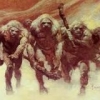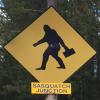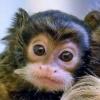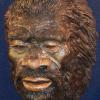Leaderboard
Popular Content
Showing content with the highest reputation on 12/09/2013 in all areas
-
Boolywooger: Maybe this might help. It is actually a response to a PM I received some time back. I have edited and expanded the original a little. I believe there are at LEAST three different types (races, sub-species, or whatever) of these things. IF AND WHEN, science ever gets the DNA from all types, it will, in my opinion, show that: (A) The largest and most intelligent of the three are the red ones whose DNA I think will show they are of mixed linage; Neanderthals and modern Caucasians. Their hair is nearly a perfect match to that of a Caucasian human's. This BF is the one most commonly seen across the country, and the one that has been shot, or shot at, hundreds of times during the past 200 or more years. They do not trust us, but continue to try to interact with us humans because they are our next of kin. They talk in their own language, and listen to ours's and imitate it in words and phrases. In the deep south, in and around very rural Black American communities, their imitations of human voices carry the distinct sounds of those folk's accents, although the basic sounds of the words are very coarse. They are devilishly smart, and very adept at figuring out deliberately arranged multiple complex latch mechanisms placed on rural feed barns, smoke houses and food storage buildings by older folks who tried to keep them from stealing food without having to shoot them. A very curious and common thing mentioned by older residents in the more rural parts of the South/Southwest was that if the Red BF made a habit of stealing domestic livestock or poultry, they would stop when they had stolen and carried off half the original number of that type of animal. In the mountains of KY, AL, AR and WV I repeatedly heard statement for years from residents who had found caves, mine entrances (adits) and sheltered areas under rock overhangs that had been used as "homes" for family groups of the animals. One common element of their accounts was that the sites contained the remains of many types of birds and animals, and the remains were somewhat neatly piled and separated in the immediate area. The toilet area away from the "dens" was also reported to be used by all the group. I was a little surprised fairly recently when I read a scientific article about Neanderthals in which the investigators stated those ancient people "Kept a very tidy home". I do know from my own experiences - and have mentioned it to many people - that the Reds are neat freaks. Bear, coyotes, 'coons and o'possums may eat packaged food left in the woods, but there will be teeth marks and torn packages scattered about, but if the food is eaten by a BF, the packages will be carried off or opened by hand and the packages left in a neat pile. (B)The second type's physical features are more like those attributed to more distant human ancestors. They are more ape-like in appearance and actions than the "Big Reds". Their hair is black, and curled close to their body. Their hair under the microscope more closely matches that of an African human. They are more aggressive toward humans and prone to throwing objects directly toward intruders. If more than one is in the area of a human at night, they will charge as a group; just as the Howler monkeys of South America do. (3) The third type also has black hair, but that hair is straight & finer. They are taller, slimmer and not as aggressive as the other black-haired one. I suspect their hair would be what Forensic Hair Experts would label as Mongoloid (Asian). This type apparently live in tight families, seldom stray outside their chosen territories and are not highly aggressive toward humans unless they approach a family group's "home turf" at night. Reports of sightings (or night-time vocal encounters) of this type of primate, at least as far as I know, have come from only the Deep South. Those people who have the most knowledge about them call them "Water Apes" because they live and forage alongside of or in deep creek or river channels. What I have not mentioned is the odd primates seen and reported in some southern areas. Their tracks look like a cross between the tracks of baboon and a orangutan. (Photos of those weird tracks and the descriptions and actions of one of those weird primates is included in a long report I wrote of a family's long history of dealing with a mixed group of primates.)2 points
-
If you think about it? Nothing is beyond the reach of science......it can all be weighed and measured, even if we lack the ability for now.1 point
-
1 point
-
Swallow as little or as much as you can comprehend. Personally, I'll discuss all those I've studied;. Of course I would not attempt to suggest the limit of your discussion, but for the sake of your sanity, I would suggest you stick with one.1 point
-
1 point
-
If you think about it? Nothing is beyond the reach of science......it can all be weighed and measured, even if we lack the ability for now.1 point
-
In the interest of assisting in this endeavor, I would like to offer some constructive criticisms and suggestions. I think I can offer some unique insights into this matter as I am one of the rare, fortunate few who have actually been behind closed doors at the Smithsonian to conduct research, albeit in a completely non-related field. First I will relate my constructive criticisms and then tell of my own experience, and others can glean from it what you will. In my experience HF you are hitting the nail on the head, but unfortunately didn't take it quite far enough. I would strongly suggest you do some research on the Smithsonian’s website and find the specific curator who would be most likely be in a position to assist you and contact them. A generic "to whom it may concern" will most likely get you an equally generic response. In their eyes, you have already lost traction as a serious researcher because you couldn't be bothered to find the specific person you need to talk to, or had been possibly been recommended by one of their peers. Indeed, they receive hundreds if not thousands of inquiries per year, and a variety of underlings are tasked with filtering out those inquiries. As incredulous as it may seem, they are underfunded and understaffed as most museums are, and this being "THE" museum of the western hemisphere, they plain do not have the time to answer fully every off the wall inquiry or request. To JDL, I can understand how the average person would conceive an idea such as you have. I don't mean this as a personal swipe or insult, but your idea is in some ways putting the cart before the horse and, quite frankly making the situation far more complicated than it is. The initial thing to do is establish if these artifacts exist or if they are willing to entertain said research. The reality of the situation is, most museums and archives are quite easy to get into if you demonstrate you have some sense and actually bother to apply yourself. Keep in mind, most of these facilities are publicly funded, and in a sense, belong to "we the people" and are there to serve us. Their stated mission is generally to educate, and many curators are more than happy to be of assistance if for no other reason than to talk about their favorite subject with someone else. Admittedly though, others are not so inclined, and will purposefully erect barriers to avoid having to deal with the public. The Smithsonian (at least in my experience) was initially more of the latter, and I just happened to get lucky in the end. They are a federal bureaucracy after all with a lot of disinterested staff. I do a great deal of work as an independent researcher and about a year ago wanted to see what artifact holdings the Smithsonian had in my field of interest. I prowled the internet and found the name of the curator who was most likely able to assist me and emailed her directly. I kept my message fairly brief and to the point of what I was looking for and who I was. She responded within the next day or two and said yes, they had some artifacts that would be of interest to me. I then set up an appointment with her (at a date and time convenient to her) and within two weeks I went to meet with her. There were no background checks, no ID submitted, no pedigrees asked for...nothing. I should point out the items I was seeking to look at are exceptionally rare and valuable, not common garden variety objects found just anywhere. I entered the meeting with a professional demeanor and prepared to do my work. While examining the artifacts, conversation naturally ensued and I was thereby able to demonstrate I was knowledgeable about the topic (more-so than the curator herself) and "worthy" of being granted access. I use the term "worthy" because I was soon to discover that those given access to the collection are somewhat arbitrarily and subjectively chosen. As the details of my mission unfolded (I was seeking to make museum quality reproductions of the items I was looking at) the curator confessed that had she known what I was wanting to do, she would have never granted access! Not because I wanted to replicate them, but because so many goofballs and wackos are in my field of study, they summarily dismiss them because the staff doesn't want "those people" wasting their time! She further admitted that she thought I had been given her name by a peer of hers, and thus thought I would be okay to allow in; even though at no point had I stated or even implied such. All is well that ended well, I went back for another two visits to complete my work, confident that I had established myself as a serious researcher in her eyes. As it turned out, in a conversation with one of my peers, he was incredulous that I had gotten in, as he had been denied access for over 20 years, and even been told that 'no, we don't have any of that stuff.' Again, this was in a completely unrelated field to BF or any other kind of paranormal or controversial study, so charges of a conspiracy to suppress information do not apply here. In the end, my general observation was that luck is the biggest determining factor. By and large, the staff at the Smithsonian for one reason or another don't want to fool with average researchers, but MAY on occasion allow it. It as much seemed to revolve around finding the right curator who just happened to be in a good mood that day to allow me in. Granted, this may just be the pervasive attitude in the department I was dealing with, but I wouldn't be surprised if it is not an across the board type mindset. So hopefully this has been of some assistance and I sincerely hope you can get a positive response from them, though I wouldn't hold my breath.1 point
-
I think part of the problem in evidence in this discussion is the traditional Western European "hierarchy of abilities" judgement attached to the collection of evidence. Technology and it's development is for sure a valuable attribute for our species but not necessarily the best adaptation to environment. It's taken centuries of development for us to be able to live in extreme arctic environments successfully, while other species of animals have developed superior adaption much more efficiently. This is just once example. Superiority is relative to the task at hand.1 point
-
I don't think there was much screening by morphology. I'm really not sure what merited inclusion of a sample but it looks like location of where it was found was one factor and another might have been in the submitter's presentation of the sample. Since Sykes felt like he was in one way answering the call of cryptozoologists for science to take them seriously he may have wanted to take their word for their samples and then deliver a lesson on being so certain about them. We learn as much through finding the negatives as we do the rare positive, if not more. I think he was generous to spend his own money doing the tests, but perhaps well enough compensated through the documentary. I think his results are probably acurate, and he just might have something about humans to put in his paper. He might be treating the bear results differently on the Yeti samples., Sort of like the new trend in science is to share the data prior to writing it up in a paper.1 point
-
Well, the most hair-raising example is their ability to slip in to within 15 or 20 yards of me or a group without making a sound after I (we) had played recorded BF sounds. When no response was heard after about 30 to 45 minutes, and we relaxed and started walking around or talking/laughing, one or two of them would make a limb-breaking and rock kicking bluff charge through the thickest brush to within a few feet of us. Of course they would then run like crazy out of hearing. One night - when there was five in my group of tourists - right after I played a call, a coyote came charging in from the north and was within a few few of two of the folks.(It was whining like a coyote but we didn't see it). The coyote (?) then left without a sound. Everyone huddled, scared as the dickens, and after a few minutes the two women began laughing loudly. At that time we were looking north, some with flashlights. Then a BF huffed from about 15 yards away south and bluff charged through a very dense thicket. He came crashing through the stuff to within about ten feet of us. The group beat me to the trucks only because they were younger. Some have used my cooking pots and pans for target practice with pine cones, sweet gum balls or acorns at night when I would be cooking dinner and step away from the camp stove for a few seconds. When they did that, I would face the woods on that side and ask them to "stop that" in a normal tone of voice. They always did. (There was a large tarp awning over my "kitchen", the objects were thrown "straight line". Running by the camp and then slipping back to push down big dead trees, then running back by camp in the other direction is some more of their macho, "showing out" things.1 point
This leaderboard is set to New York/GMT-05:00









